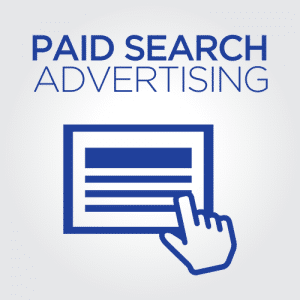Marketers doled out an estimated $83 million for paid search advertising in 2016 – and experts predict that figure to jump to $92.4 million in 2017. Remember that content – in your ads, on your social profiles, and on your web pages – is ultimately what converts consumers.
Paid search advertising is a great way to position yourself for a virtual handshake with new users, but building a natural relationship with them is critical to lasting success.Decipher the hype surrounding this digital marketing trend in our info-packed guide about paid search advertising.
What is Paid Search Advertising?
When you type a keyword into a search engine, two different types of listings appear: organic and paid. Organic search results are unpaid listings that naturally gravitate toward the top of each search engine results page (SERP) as a result of high-quality text or images, SEO optimization, and effective meta tags. Paid search results are listings that appear at the top of each SERP after marketers pay a fee. We’ll delve deeper into the fee aspect later in this guide.
Organic search results account for as much as 95% of desktop traffic, but we have some reassuring statistics if you’re considering paid search advertising. Less than 50% of mobile traffic comes from organic search results, and organic search visits plummeted by 7% the second quarter of 2016. As the number of paid search listings increases, it becomes more difficult for marketers to rank their websites organically, particularly on mobile. That means your carefully planned paid search budget isn’t going to go to waste.
How do you use Paid Search Advertising?
There’s no cookie-cutter formula for implementing paid search advertising techniques. Rather than devoting an entire marketing budget to fee-based searches, many website owners use paid listings to enhance their overall SEO plan.
Incorporating paid listings into your marketing program can help you:
- Increase traffic for specific search terms
- Promote awareness for special events or low-selling products
- Establish your identity as an expert by securing a digital spot beside well-known, highly ranked companies or individuals
- Improve organic traffic by freeing you up to tweak outdated content
You can use paid searches to promote an entire website, but you may find it beneficial to focus on specific pages.
This helps you track the behavior of visitors to each page, which makes it simple to establish patterns regarding demographics and sales. Once you figure out what your visitors want, you can easily tailor content to meet their needs.
But what about your needs? If you haven’t already, it’s important that you establish goals for your website.
Potential goal ideas include:
- Increasing the number of visitors to a specific page
- Getting fans to sign up for an eCourse or coaching program
- Convincing followers to buy tangible goods that you offer
- Encouraging visitors to sign up for a free trial or convert to a paid trial
- You can use paid search listings to experiment with multiple landing pages. When you monitor traffic and conversions to each landing page, you learn which sales spiels attract readers and which ones scare them away. This is called A/B testing.
There are several ways to perform A/B testing with paid search results. You can add multiple destination links to a single listing, or you can create several paid ads and use a different link for each one. You can focus on similar keywords if your website falls into a clearly defined niche or target a variety of keyword phrases if you offer a diverse selection of goods or services.
You can also perform A/B testing with organic search listings, but you may find it more difficult than tracking conversions with paid listings. You have less control with organic search listings, so it’s hard to determine whether a poor conversion rate is the result of a product that doesn’t interest your readers or a poorly ranked landing page buried far beyond the first or second page of Google’s search results. Paid search ads send interested parties directly to predetermined pages when they browse specific keywords, making it easier for you to accurately track conversion results.
While we’re on the subject of keywords, let’s discuss how paid search ads can help you find new search phrases to target. Although other paid search options exist, we’re going to use Google AdWords in the example that follows. Google receives more than 4.4 billion searches per day, which is more than Yahoo, Bing, Lycos, Ask and AOL combined. This is why many people focus on attracting Google visitors when they invest in paid search marketing.
Imagine that you sell merchandise adorned with images of cuddly kitties. You might decide to bid on keyword phrases like “cute cat tees” or “coffee mugs with kittens,” but Google might also send traffic from Web users who type “adorable kitten shirts” or “coffee cups with cats.” Google AdWords lets you track keyword searches that bring visitors to your website, which helps you determine who else is looking for your products. You can use this information to purchase additionally paid advertisements or sprinkle relevant keywords into your blog posts, product descriptions or landing pages.
Who are your competitiors?
Whether you’re selling cat-covered coffee mugs or providing virtual coaching sessions, it’s safe to assume that you have some competition in the digital world. You might dominate the first page of Google for “cute cat tees,” even without purchasing a paid ad, but what if your competitors hold the top spots for “adorable kitten shirts” and “coffee mugs with kittens”?
You can rectify this situation by purchasing paid Google search advertising for the phrases your competitors are doing well with. You can also purchase paid ads for search terms that lead to similar pages that aren’t necessarily competitors. Basically, you’re increasing your visibility across the web so that visitors find you instead of someone else.
However, keep in mind that paid Google ads aren’t enough to make your website popular. You still need to practice strong SEO, create a user-friendly site layout and keep your promises to your readers. Don’t attempt to catfish your visitors by drawing them in with a keyword that isn’t relevant to what you or your business actually offer. This destroys trust and annoys readers, which means they probably won’t return to your site.
How does Paid Advertising work?
Paid search advertising is a three-part process that includes keywords, paid ads and landing pages. You can’t omit any of these elements, as each one plays a vital role in the success of your paid search campaign.
Keywords
Earlier in this guide, we discussed how keywords help readers who are interested in your content or products find you. Keywords are the first step of the paid advertising process because it’s silly to create an ad or send readers to a landing page if you aren’t targeting relevant keywords. Even if you want to skip keywords during your marketing campaign, programs like Google AdWords don’t let you.
But what if you’re not sure what keywords you need? Well, Google AdWords has a handy keyword planner that helps you determine which search phrases are ideal for your advertisements. The planner displays information about keyword trends, so you can determine whether it’s best to use a broad keyword phrase or create a highly targeted keyword.
Confused about the difference between the two? Let’s say you sell women’s clothing and are having a sale on tops. “Shirts for women” is a broad keyword phrase. “Pink V-neck shirts” and “yellow blouses for plus-size women” are more specific. You may reach more readers if you choose “shirts for women,” but you might have more clicks or conversions if you select a specific keyword phrase.
Many advertisers opt for a combination of the two. You can experiment with different search terms during your A/B testing, which we referenced earlier. You can also review detailed breakdowns of potential keywords, including how popular they are and how much competition you have, when you use Google’s keyword planning tool.
Paid Ads
After you choose relevant keywords for your campaign, it’s time to create paid ads. Your ads should reflect the niche that you’re targeting. Make sure they are concise, engaging and informative. They should also be honest. Do not promise things you can’t deliver, such as a free products or services at unusually low prices, just to get readers to click on your ads. This is unethical, and it isn’t likely to benefit you.
You don’t have to be a marketing pro to create paid ads for Google. Google AdWords has tools that make it simple to create short ads in just 10 or 15 minutes. You can also hire an experienced marketing writer to draft ads for your campaign.
Landing Pages
Landing pages are where the action happens. You need strong keywords and effective ad copy to drive visitors to your landing pages, but once they arrive, you have a chance to seal the deal when it comes to signups or purchases. If your goal is simply brand awareness, you may still want to offer your readers something, such as a free eBook download or an info-packed newsletter.
Be careful not to spam your visitors when they arrive on your landing page. Sales copy is fine, but don’t include a bunch of popups for other products or services. This confuses readers and detracts attention from your primary goal. If you want visitors to take additional action in the future, use your landing page to collect their email address. That way, you have permission to contact them about other opportunities in the future instead of overloading them with information during an initial visit.
CPM versus PPC bidding: Which one is right for you?
CPM bidding refers to cost per thousand bidding. If you’re wondering where the “M” came from, we have the answer. The number 1,000 is written as “M” when you use Roman numerals, so that’s why you see an “M” and not a “T” in the acronym for CPM bidding.
When you use CPM bidding for your paid search marketing, you pay for impressions rather than clicks. That means if someone sees your ad but doesn’t click on it, you still have to pay for the view, and you pay per every thousand views.
Paid per click bidding is typically called PPC bidding. Unlike CPM bidding, you only pay for actions that actually occur. If someone clicks on your ad, Google AdWords deducts money from your account.
The type of bidding you choose depends on your budget and your marketing goals. CPM bidding is ideal if you want to increase brand recognition. It’s basically the equivalent of saying, “Hey, here I am” and hoping readers remember you later. PPC bidding is best if you have a small budget or intend to convert visitors into subscribers, buyers or applicants after they reach your landing page.
If you choose PPC bidding, it’s important to know that costs vary. Your ads might cost more than similar ads, so sometimes it’s difficult to estimate an exact figure when you chat with other marketing professionals. Google establishes per-click costs with an auction-like process where the highest bidder gets the best position on each page.
However, a high bid doesn’t guarantee ad placement. If and when a high-bid ad appears, visitors see it near the top of the page. If it doesn’t appear very often, it might be because Google has given your website a low quality score.
Quality Scores
Google ranks content quality on a scale from 1 to 10, with one being the lowest and 10 being the highest. A low-quality score doesn’t necessarily mean your website is awful; it just means that it doesn’t have content relevant to the keywords that you selected for your paid ads. It also means your ads might not display as often as you like.
If your content is relevant, it’s possible that the following issues have impacted your website’s quality score:
Content from our partners
- Grammatical errors
- Spammy posts or a high ratio of ads versus nonpromotional content
- Gibberish or confusing content
- Low-quality images
- Inappropriate content that violates Google’s policies
- A confusing layout that’s difficult for visitors to navigate
- High bounce rate
Quality ratings are a great illustration of why we always recommend paying attention to solid content and creating natural relationships with your audience. Strong content and a loyal following go a long way to mitigating these issues and making it easier to launch successful ad campaigns.
Keyword match types
There are three keyword match types, and the one you choose lets Google know when to display your ad. You have the option to use exact match keywords, phrase match keywords, and broad match keywords when you select a type.
When you ask Google to only display ads for exact match keywords, you’re telling the search engine that you don’t want any deviations from the keyword phrases you’re targeting. That means if you buy the keyword “cowboy boots women,” your ad only appears when someone types in “cowboy boots women.”
Let’s use the same keyword to explain phrase match keywords. A phrase match refers to a keyword phrase that contains the same words, in the same order, as your original keyword. However, the ad still appears if a website user adds a few terms in between. For example, someone can type “cowboy boots for women” instead of just “cowboy boots women” and still see your ad.
A broad match keyword appears when a web user types something similar to your paid keyword phrase. A broad match may include the same words, but they might appear in a different order. Synonyms and words with similar meanings are also okay. If someone searches “women’s cowboy boots” or “cowboy boots for ladies,” your ad for “cowboy boots women” might appear.
Paid Search Advertising strategy types
There’s no one-size-fits-all formula for paid search advertising strategy. Before you develop a strategy, you have to consider your budget, goals and products/services. Here are some questions to ask yourself before choosing a strategy:
- Do I want to pay per click or per impression?
- How much can I afford to spend per day?
- Does my website focus on a single niche or cover multiple topics?
- Do I just want to establish a digital identity, or am I hoping for conversions?
- Do I want to attract readers who aren’t specifically searching for what I offer or stick with highly targeted traffic?
- Am I interested in local search marketing or global search marketing?
- Am I focusing on mobile search marketing, or do I also want to target desktop users?
If you’re new to paid search marketing, you might want to execute your first campaign using broad match keywords. This sends a high volume of visitors to your landing page, and it also gives you a chance to track search trends. You can view the analytics for each visitor to figure out what phrases they’re searching for. This lets you easily tweak future ads, especially if you want to switch to exact match keywords.
Once you have several popular keywords for your paid ads, you can create ad groups on Google AdWords. Ad groups let you combine relevant keywords in one convenient place. If you sell makeup, you can create different ad groups for lip gloss, mascara, and foundation. The group for lip gloss might contain keyword phrases like “shiny lip gloss” and “red lip gloss.” This gives you a chance to target multiple search phrases without combining irrelevant terms, such as “lip gloss” and “mascara,” in one ad.
When you’ve decided which keywords to target, it’s time to set a daily budget. Google respects your budget and won’t exceed it, but there may also be days when you don’t use your entire budget. This depends on various factors, including search trends and your quality score. Luckily, you only pay for actual usage, not for the number of clicks or impressions you hope to receive.
If nobody is viewing or clicking your ads, consider their structure. Do you have relevant, captivating copy? Are you following Google’s ad guidelines for length? A Google ad must meet the following length requirements:
- 25 max characters for the title (the first line of your ad)
- 37 max characters for the display URL (the URL readers see, which may be different than the site’s actual URL)
- 35 max characters for each description line in your two-line description (a brief summary of the ad’s purpose or destination)
In a two-line description, you may want to make the second line a call to action, such as “Click here to learn more” or “Enroll today”. This encourages readers to take specific steps after they view your ad.
If you’re thinking about creating your own online marketing plan, remember that there are numerous ways to approach Google search advertising. For a successful paid search advertising campaign, it’s vital that you follow Google’s guidelines, create quality content and utilize ethical marketing practices.












